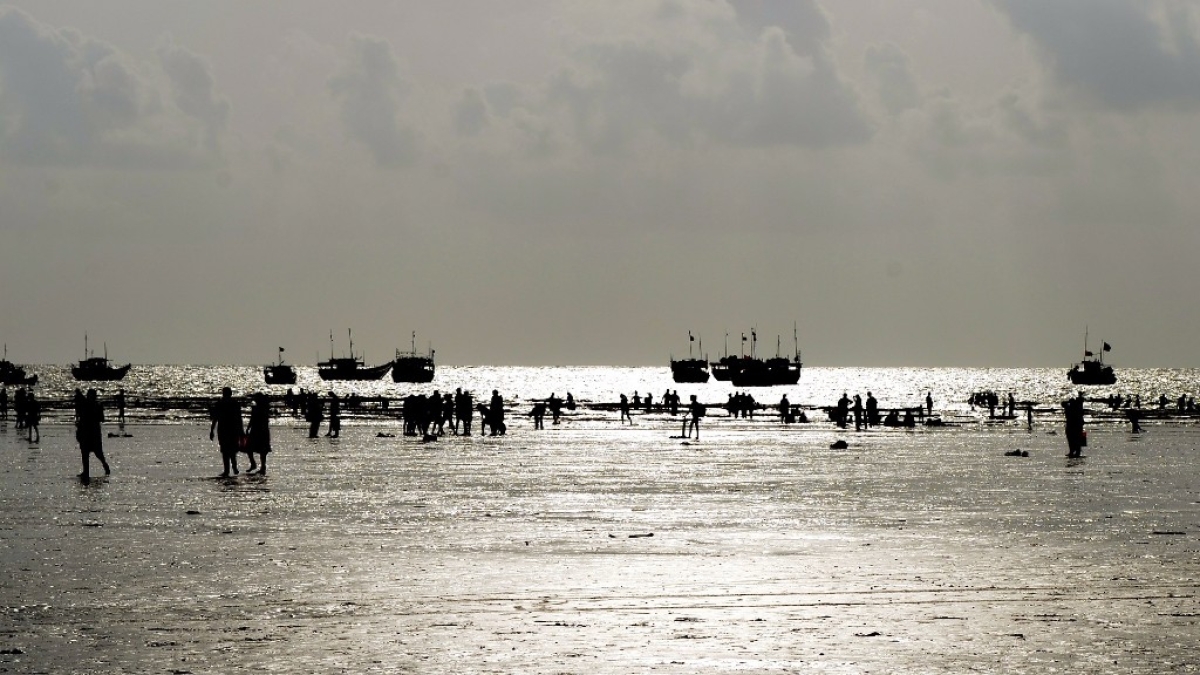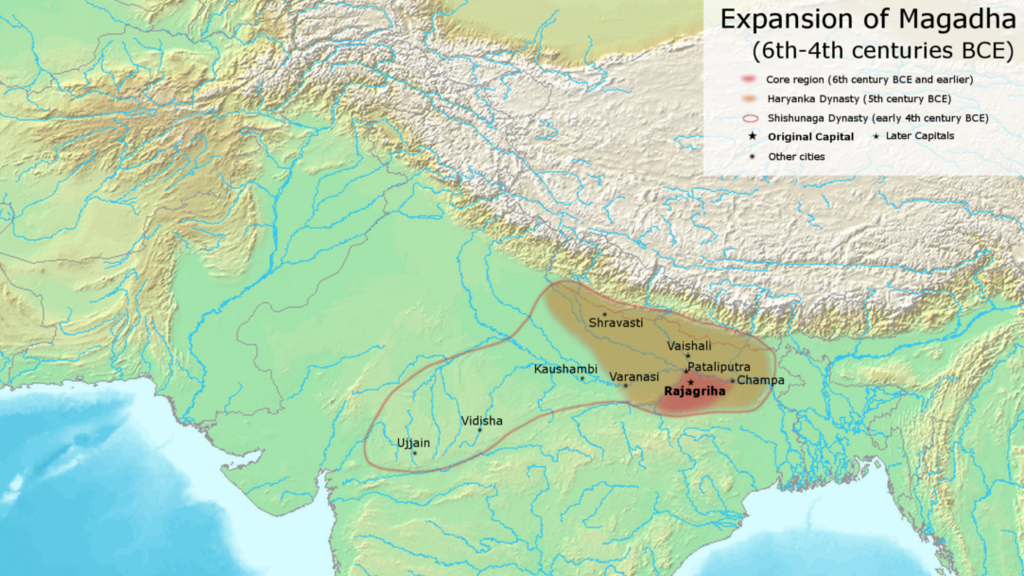The emergence of the Magadha Empire in the 4th century BC carried the process of politico- administration evolution to its climax. It was the first empire in the Indian subcontinent. It covered an extensive territory beginning from Hindukush Mountain in North-West & to Bengal in East Kashmir Valley in North to Karnataka in South. Magadha was one of the 16 Mahajanpada in 600 BC. It could expand rapidly and could get transformed into an extensive empire while other Mahajanapadas disappeared from the scene. This success of Magadha was the outcome of several factors among these factors Magadha’s favorable Geographical location was most important. The role of Magadha rulers was also quite critical.
Role of Geographical location in rising of the Magadha Empire
The favorable geographical location of Magadha imparted its great economic strength. Magadha agriculture, industries & craft as well as trade & commerce were most developed. Magadha was located in heart of an extensive fertile alluvial plain. Several Perennial Rivers flowed through Magadha. The water resources were available in plenty.
The climate of the Magadha region was also suitable for agriculture. As a result of these favorable factors agriculture was brightly developed in the Magadha region. A huge amount of agriculture surplus was available with peasants. The Magadha could huge resources through taxes and this strong material foundation paved the way for the emergence of a powerful empire.
Magadha arts & crafts were also in a highly developed state because of the availability of iron mines in the Magadha region and the huge demand for manufacturing goods. Magadha trade & commerce was also in a developed state because of huge internal demand, as well as control over routes of external trade.
Uttarapatha – The most important route of mountain trade passed through the Magadha region.

Tamralipti the most important part of external trade was also under the control of Magadha rulers. The favorable geographical location of Magadha allowed Magadha rulers to tax not only on its own trade & commerce but also on trade & commerce of others because imparted land, as well as river routes of North Indian trades, passed through in control over Tamralipti also helped Magadha rulers to tax on other.
This remarkable economic progress facilitated by favorable geographical location prepared a solid material foundation for the emergence of the Magadha Empire. Such extensive resources were absent from other contemporary states because of that they could not compete with Magadha. It was this strength of economic that Transformed Magadha imperialism into an invincible force as a result of which the process of rising of Magadha could continue unabatedly.
Favorable Political & Military strength of Magadha
The favorable geographical location of Magadha imparted great political-military strength as well. The Magadha capital enjoyed natural defense. The early capital Rajgraha was surrounded by 5 hills & the later capital Patliputra was surrounded by 3 rivers (Ganga, Sone, Punpun) Patliputra was famously known as “Jaldurga”.

This natural safety enjoyed by Magadha capital allowed Magadha Rulers to concentrate more effectively on aggressive territorial expansion. As result, Magadha imperialism was far more effective than other contemporary kingdoms. The local availability of iron mine allows Magadha Rulers to use iron weapons freely. As a result of this Magadha, the army was far stronger when compared with other contemporary states.
Elephants were available only in the forest of East India at that time because of this Magadha Rulers could raise a powerful element force. This elephant force was the main difference between the armies of Magadha and other states. The enemies used to run away by hearing the sound of the elephant force.
Timber was also available in plenty in the Magadha region. As a result of this Magadha, the ruler erects a defensive wall & could use chant during wars & battle on large scale. According to Mayastheus, the city of Patliputra is surrounded by a wooden palisade. The remains of this wooden wall have been found at Bulandi Bagh and Gosai Khanda (Both located near Patna).
Favorable Social & Cultural strength
Magadha was located outside pale of holy Aryawrata. As a result of this, the Brahmical ideas such as Varna, Ashram, and Dharma system weren’t (duties & responsibilities) being followed rigidity. This socio-cultural liberalism allowed Magadha rulers to recent members of all the 4 members of armed forces.
According to Arthashastra, Brahma, Kshatriya, Vaisya as well as Shudras were recruited in the army. Because of this Magadha rulers could raise a large army & this military strength allowed Magadha Rulers to pursue the policy of territorial expansion successfully.
Since the Magadha region located outside holy Aryawrata Magadha people were pragmatic & materialistic in their outlook. They invested their time & energy in the progress of their eco-act rather than coming about otherworldly complex philosophy. Because of the flexibility of socio-cultural outlook in the Magadha region, social stress & strain prevailing in Aryavrata were absent. This social stability also played important role in the emergence of the powerful Magadha Empire.
Role of Rulers
The Magadha rulers like Bimbisara, Ajatshatru, Shishunag, Mahapadmananda, Chandragupta Maurya, and Ashoka also contributed immensely to the success of Magadha imperialism & the emergence of the extensive Magadha Empire. Bimbisara was the founder of the Harayanka dynasty. He used the policy of matrimonial alliances as well as wars & battle to carry out the territorial expansion of Magadha.

Bimbisara married Lichahhvis, Kosala, Matsya (Jaipur-Viratnagar) & Modra dynasty. He received village Kashi in dowry from Kosala. This village provided revenue of 1 lac Pana / annum. Bimbisara conquered the Anga region. As a result of which Tamralipti port came under Magadha control.
Ajatshatru fought the war against Kosala & Vajji confederacy. Vajji’s defeated by him after 16 long year struggle. Shishunag completed the conquest of Avanti. The war with Avanti was going on for the last 100 years was brought to end successfully.
Mahapadmananda was a great conqueror. He exterminated the number of republic kingdom located in central India and East India. Kalinga was conquered by him as informed by the Hathigumpha (cave) inscription of King Kharvela. He extended the boundaries of Magadha up to Punjab in the west.

These military conquests of Mahapadmananda transformed Magadha into an empire. Chandragupta Maurya extended the frontier of Magadha to up to Hindu Kush Mountain & Makran coast in North West Kashmir valley in North & Karnataka in South. This process of the rising of Magadha carried to its climax by Ashoka through the conquest of Kalinga & by adopting the policy of Dhammaghosha, Ashoka consolidated Magadha Empire successfully. As a result of which prestige of Magadha reached Kingdoms located far away from India.

